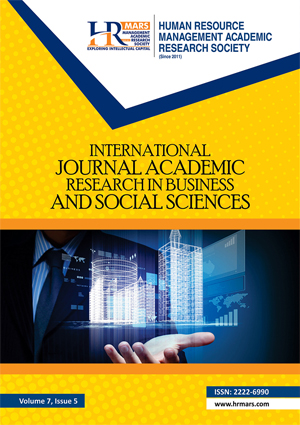
ISSN: 2222-6990
Open access
Cross-border activity especially in border towns is becoming increasingly important. There have been few studies of cross-border shopping and yet most of them have focused on macroeconomic effects rather on discovering the motivation, behavior and personal characteristics of cross-border shoppers who purchased abroad. This study aims to look the purchasing pattern of visitors at the cross-border informal market of Serikin, Sarawak according to the shopping’s behavior of the visitors. By using descriptive analysis, this study found that, the main purpose visitors come to Serikin once per month with friends by using their own cars and spend less than 4 hours is for shopping. On average, they spend less than RM 499 on other cost (transportation, foods & beverages and others) and there are only five items frequently buy by the visitors at Serikin that are clothes, vegetables, foods, electrical tools, and handicrafts. It is obvious that visitors come to Serikin for shopping. Although visitors come to Serikin with large quantity of money for shopping, but their expenditure will determine by their income.
Anaman, K. A., & Ismail, R. A. (2002). Cross-border tourism from Brunei Darussalam to Eastern Malaysia: an empirical analysis. The Singapore Economic Review, 47(1), 65-87.
Awang, A. H., Sulehan, J., Bakar, N. R. A., Abdullah, M. Y., & Liu, O. P. (2013). Informal cross-border trade Sarawak (Malaysia) – Kalimantan (Indonesia): A catalyst for border community’s development. Asian Social Science, 9(4), 167.
Bygvra, S. (2009). Distance and Cross-border shopping for alcohol. The Journal of Economic Perspectives, 26(2), 141-163.
Chatterjee, A. (1991). Cross-border Shopping: Searching for Solution. Canadian Business Review, 18(4), 26-28.
Di Matteo, L., & Di Matteo, R. (1996): An analysis of Canadian cross-border travel. Annals of Tourism Research, 23(1), 103-122.
Ibrahim, H. F., & McGoldrick, P. J. (2003). Shopping choices with public transport options. Burlington, VT: Ashgate Publishing Company.
Jang, S. S., Bai, B., Hong, G. S., & O’Leary, J. T. (2004). Understanding travel expenditure patterns: A study of Japanese pleasure travelers to the United States by income level. Tourism Management, 25(3), 331-341.
Jones, M. A. (1999). Entertaining shopping experiences: An exploratory investigation. Journal of Retailing and Consumer Services, 6(3), 129-139.
Ju, P. (2011). Research on the characteristics of spatial behavior of Hong Kong cross-border Consumer. International Journal of Retail & Distribution Management, 18(4), 8.
Kuncharin, W., & Mohamed, B. (2013). Cross-border shopping motivation, behaviors and ethnocentrism of Malaysian in Hatyai, Thailand. International Journal of Social, Education, Economic and Management Engineering, 7(4), 1017-1027.
Lee, H. C. (2002). Determinants of visitor expenditure on a local festival: A tobit analysis. Tourism Research, 26(1), 31-46.
Lehto, X. Y., Cai, L. A., O’Leary, J. T., & Huan, T. C. (2004). Tourist shopping preferences and expenditure behaviors: the case of taiwanese outbound market. Journal of Vacation Marketing, 10(4), 320-332.
Miller, D. (1998). A Theory of Shopping. Itaca, NY: Cornell University Press.
Mok, C., & Lam, T. (1997). A model of tourists’ shopping propensity. A case of Taiwanese visitors to Hong Kong. Pacific Tourism Review, 1(2), 137-145.
Abdul Ghafar, M. N. (1998). Penyelidikan Pendidikan, Johor Bahru: Universiti Teknologi Malaysia.
Ng, C. F. (2003). Satisfying shoppers’ psychological needs: From public market to cyber-mall. Journal of Environmental Psychological, 23(4), 439-455.
Oh, Y. (2007). An exploration of tourist shopping (Doctoral dissertation, Texas A&M University).
Papadopoulos, N. G. (1980). Consumer outshopping research: review and extension. Journal of Retailing, 56(4), 41-58.
Piron, F. (2002). International out shopping and ethnocentrism. European Journal of Marketing 36(1/2), 189-210.
Pysarchik, D. T. (1989). ‘Tourism Retailing’. In Tourism Marketing and Management Handbook edited by Witt, S. and L. Moutinho. London, Prentice Hall: 553-556.
Sekaran, U. (2003). Research methods for business: A Skill Building Approach (4thed.). New York: John Wiley & Sons Inc.
Subramaniam, T., Devadason, E., & Sundaraja, S. (2008). Cross-Border shopping behavior of Bruneians in Limbang, Sarawak: A preliminary analysis. Fakulti Ekonomi & Pentadbiran University of Malaya.
Sullivan, P. M., & Kang, J. (1997). Information Sources and motivational attributes of Canadian cross-border shoppers: Apilot study. International Journal of Commerce & Management,7(1), 88-107.
Tansuhaj, P., Ong, W. C., & McCullough, J. (1989). International outshoppers: What are they like? Singapore Marketing Review, 4, 93-7.
Timothy, D. J., & Butler, R. W. (1995). Cross-border shopping: A north American perspective. Annals of Tourism Research, 22(1), 16-34.
Tomori, M. (2010). Investigating shopping tourism along the Borders of Hungary - a Theoretical perspective. GeoJournal of Tourism and Geosites, 6(2), 202-210.
Uzzell, D. L. (1995). The Myth of the indoor city. Journal of Environmental Psychology, 15, 299-310.
Wagner, B. (2004). Shopping choices with transportation options. Tourism Management, 25, 811-814.
Wang, D. (2004). Hong Kongers’ cross-border consumption and shopping in Shenzen: Patterns and motivations. Journal of Retailing and Consumer Services, 11(3), 149-159.
Yeung, R., & Yee. (2012). A profile of the Mainland Chinese cross-border shoppers: Cluster and discriminant analysis. Tourism Management Perspectives 4, 106-112.
In-Text Citation: (Amar et al., 2020)
To Cite this Article: Amar, S. N., Djafar, F., Arip, M. A., & Hassan, M. K. H. (2020). Shopping’s Behaviour of Visitors at the Cross-border Informal Market of Serikin, Sarawak. International Journal of Academic Research in Business and Social Sciences, 10(7), 474–486.
Copyright: © 2020 The Author(s)
Published by Hrmars (www.hrmars.com)
This article is published under the Creative Commons Attribution (CC BY 4.0) license. Anyone may reproduce, distribute, translate and create derivative works of this article (for both commercial and non-commercial purposes), subject to full attribution to the original publication and authors. The full terms of this license may be seen at: http://creativecommons.org/licences/by/4.0/legalcode